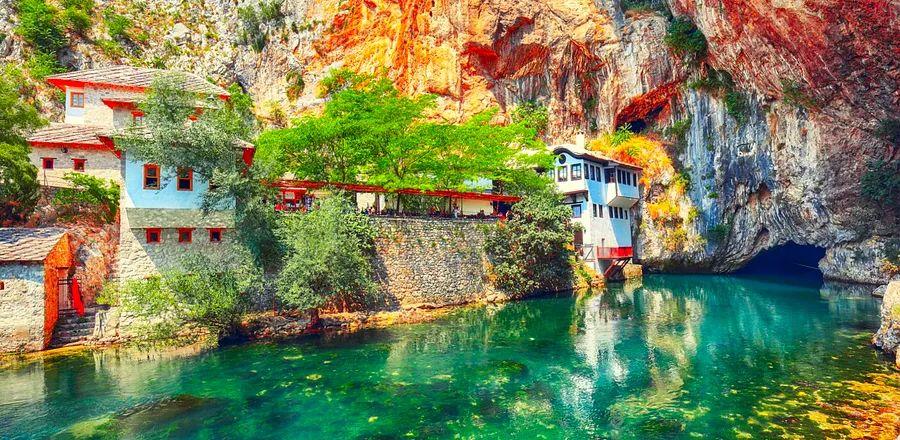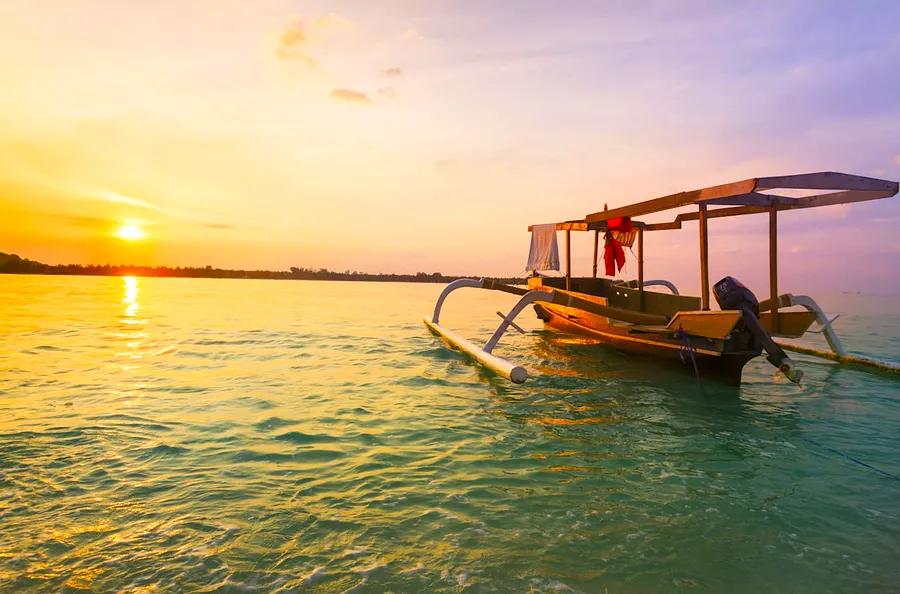Discovering Hope Amidst the Natural Beauty and Historic Towns of Bosnia and Herzegovina

As the sun sets, casting a golden hue over Mostar in Bosnia and Herzegovina, I stroll across the Stari Most, or Old Bridge, arching gracefully over the turquoise waters of the Neretva River. I observe young couples indulging in wine tastings along the bridge and riverside restaurants serving plates of cevapi (lamb kebabs with somun, Bosnian pita bread) against a stunning backdrop of green mountains and slender minarets. The call to prayer resonates across the river.
It's hard to fathom that everything I see, including the 16th-century Ottoman bridge, was devastated during the conflict of the 1990s that ravaged the nation. The bridge and the surrounding Old Town were reconstructed over five years as part of an international effort that began in 1999, earning designation as a UNESCO World Heritage site in 2005. Stari Most symbolizes reconciliation, yet in a country divided into two federal entities—the Federation of Bosnia and Herzegovina and the Republic of Srpska—with a decentralized government led by a tripartite presidency, a peaceful atmosphere isn’t always assured. The deep-rooted ethno-religious divisions among Orthodox Christian Serbs, Catholic Croats, and Muslim Bosniaks from the war still persist in certain areas. Acknowledging this legacy of conflict is essential, but the younger generation is eager to move forward, and a new tourism initiative may assist in that endeavor.

Photo courtesy of Annapurna Mellor / Intrepid
I’ve joined forces with tour operator Intrepid, which launched its Bosnia and Herzegovina Expedition this June. This initiative is part of a five-year, $20-million project named Turizam, spearheaded by the international development agency USAID. The goal is to promote sustainable, community- and nature-focused tourism to enhance economic stability and social cohesion, tackling challenges like high youth emigration and low female workforce participation. This initiative encompasses financial backing for businesses, industry training, and the creation of experiences that bridge various regions, such as the Herzegovina Wine Route.
The project shows great promise: In 2019, before the pandemic downturn, the country boasted the third-highest tourism growth rate worldwide, and 2023 has already become its highest-grossing year for tourism. While Mostar is undoubtedly the most frequented destination for travelers, I delve much deeper. “Most people visit Mostar and then head to Croatia or other locations,” shares our Intrepid tour guide, Elsa Lojic. “For once, I have the opportunity to lead a trip entirely in my homeland; it holds great significance for me.”
The Intrepid journey kicks off in Lojic’s hometown of Sarajevo, the capital of Bosnia and Herzegovina, nestled in a valley along the Miljacka River in the southwest. There, our group gathers for dinner high in the rolling hills above the city at the home of Mersiha and Mustafa. This couple started their business, Bosnian Cooking Lessons, in their kitchen in 2018, offering visitors a glimpse into traditional Bosnian cuisine through hosted dinners and hands-on cooking classes. In collaboration with USAID, Intrepid partnered exclusively with small, locally-owned businesses like theirs to craft the trip itinerary, ensuring travelers’ money benefits the community. “We grew up in this neighborhood, and now we share our home and culture,” explains Mustafa. Next to him, Mersiha demonstrates how to roll dough for burek—pastries filled with spinach and cheese or lamb—into a paper-thin layer on the table. Later, we indulge in these delightful mini pies alongside hot platters of peppers, onions, and cabbage stuffed with minced meat. Outside, the city’s red roofs fade into darkness, replaced by a sea of twinkling lights.

Photo courtesy of Annapurna Mellor / Intrepid
From Sarajevo, our small van winds northward, revealing a stunning panorama of forests, rushing rivers, and the majestic peaks of the Dinaric Alps. Upon reaching the enchanting town of Jajce, we check into Konoba Slapovi, a charming local hotel and restaurant nestled amidst trees and cascading waterfalls. Jajce holds historical significance as the birthplace of modern Yugoslavia, where antifascist leaders from across the Balkans, led by the communist revolutionary Tito, convened during World War II to establish the Federal Republic of Yugoslavia. This town continues to draw tourists who reminisce about Tito’s era, while also hinting at a new wave of tourism.
Strolling through the town, we come across the 14th-century Jajce Fortress and the ancient remnants of St. Mary’s Church, the oldest Catholic church in the country. This church, which later served as a mosque under Ottoman rule, stands today as a symbol of political discord, as Croats and Bosniaks dispute its ownership. Yet, it also represents a potential remedy to the ethno-religious tensions: it is part of a multicultural architectural heritage vying for UNESCO status, which could inspire unity rather than division. In smaller towns like Jajce, where schools remain segregated and interfaith marriages are frowned upon, the hope is that UNESCO recognition might cultivate a sense of shared ownership over cultural heritage, celebrating the city’s diverse religious architecture—from mosques to churches and a Mithraic temple—serving as a reminder of the strength and beauty found in diversity. With the expected tourism boost from UNESCO status, locals may begin to appreciate the economic advantages of fostering tolerance and embracing a more multicultural identity.
“This is a place where world religions can be showcased to younger generations to demonstrate how we can coexist peacefully,” remarks our guide, 32-year-old Dragan Glavas. “Tourism rooted in this heritage can remind us of our long-standing mixed culture and encourage us to learn from one another,” Glavas adds. This sentiment resonates with the residents who invite us into their homes and villages throughout the journey, whether enjoying homemade fig cake in Stolac, the nation’s oldest city, or dining outdoors in the lesser-known city of Konjic. Just outside Konjic, visitors can explore Tito’s bunker, a top-secret Cold War nuclear bunker and military command center that opened to the public in 2011 as an exhibition space for contemporary art, now offering guided tours.
Visits to lesser-known villages form part of Tourizam’s Most Beautiful Villages initiative, aimed at enhancing rural tourism. Along this route lies the town of Blagaj, where we stop at the 15th-century Blagaj Tekke, a stunning white Dervish monastery set against a towering cliff, with the Buna River flowing beside it. This site has long been a pilgrimage destination for believers, poets, and adventurers, encapsulating the mystique of the sect. Inside, I tread on worn ruby carpets, gaze at a starry stained-glass dome in a small hammam, and peruse dog-eared copies of the Qur’an resting on polished wooden shelves.

Courtesy of Annapurna Mellor / Intrepid
The promise of sustainable adventure tourism
While Bosnia and Herzegovina boasts a rich cultural tapestry, it also holds immense potential for adventure tourism. With 65 percent of its land still covered in forests and interlaced with numerous rivers and mountains, the region attracts both white-water adventurers and climbers. A newly opened via ferrata adds to the excitement, and parts of the scenic Balkans’ 1,250-mile Via Dinarica hiking trail traverse the country. This has piqued the interest of organizations like the Adventure Travel Trade Association to engage in the Turizam initiative.
Through the development of ecotourism, USAID aims to increase the extent of protected natural areas (currently, only 1 percent of the country’s territory is legally protected forests, while river ecosystems face threats from dam constructions). This effort seeks to persuade political leaders to shift focus from extractive industries and appreciate the importance of safeguarding this natural heritage—an initiative already championed by environmental advocates. Researchers are actively working to demonstrate the ecological significance of the upper Neretva River, which is currently endangered by 70 proposed dams; in 2021, Bosnian environmentalist Maida Bilal received the Goldman Environmental Prize for her efforts to protect the Kruščica River.
Though our planned white-water rafting adventure on the Neretva River near Konjac is interrupted by inclement weather, we embrace a different journey in the southwest. The scenery shifts to an arid, open expanse, adorned with yellow wildflowers scattered across fields punctuated by small clusters of homes. Our group hops into a 4x4 Jeep, navigating a bumpy dirt road that ascends high above Livno. At the Kruzi plateau, where a rugged landscape of scrubland and rocky formations extends toward the foothills of Mount Cincar, we finally come to a halt. Before us, wild horses graze and frolic alongside their colts, their manes dancing in the golden sunshine.
Once agricultural lands, these hills now serve as a home to over 700 wild horses, thanks to the efforts of tour company Continental Adventure, which offers close encounters with these majestic creatures on its Wild Horses SDinogoi. Marin Mamuza, the founder, returned to Bosnia after studying in Croatia, driven by the potential he saw in this venture. “Brain drain is a major issue in Bosnia, but tourism provides young people with reasons to return and to make different voting choices than previous generations; that’s how change will happen,” Lojic remarks.
The ground beneath us once marked the frontline in the conflict between Croat and Serb forces, and the echoes of that tumultuous time linger in the air: distant red and white markers indicate minefields—unmarked and unexploded landmines remain a danger in some remote areas, underscoring the necessity of exploring with a knowledgeable guide. A stark white cross towers on a hill, serving as a poignant memorial for Croat lives lost. Yet, three decades later, there is a glimmer of hope for a brighter future here.
This scenic plateau is where Mamuza proposed to his Croatian wife, as he shared with me. “I want to cherish this place for love, not for war.”
Evaluation :
5/5



